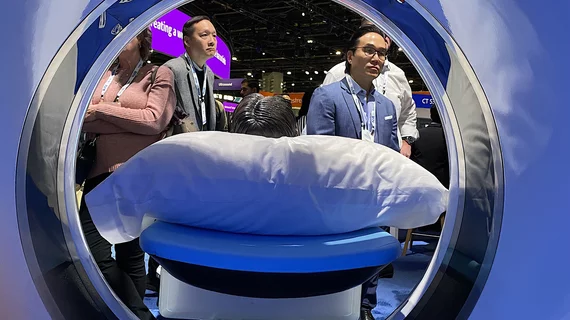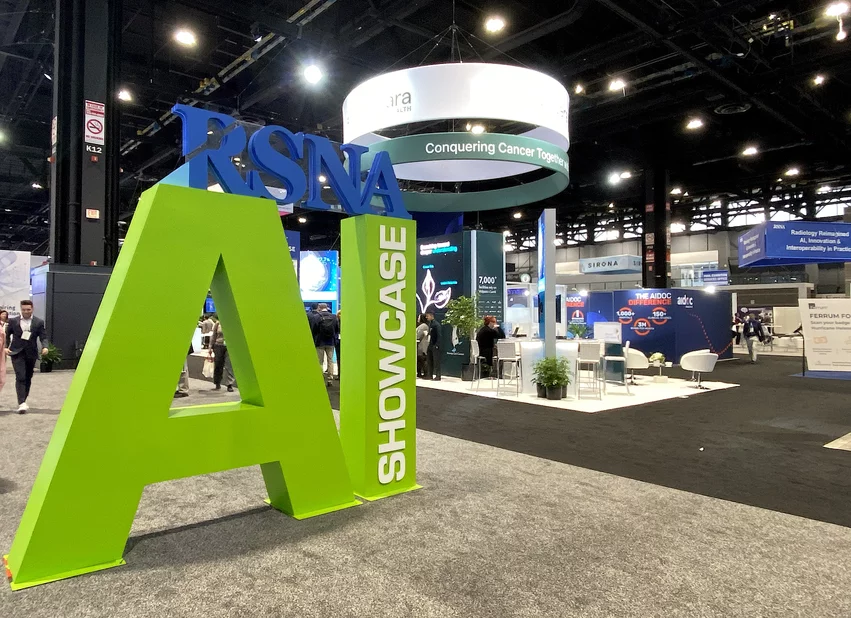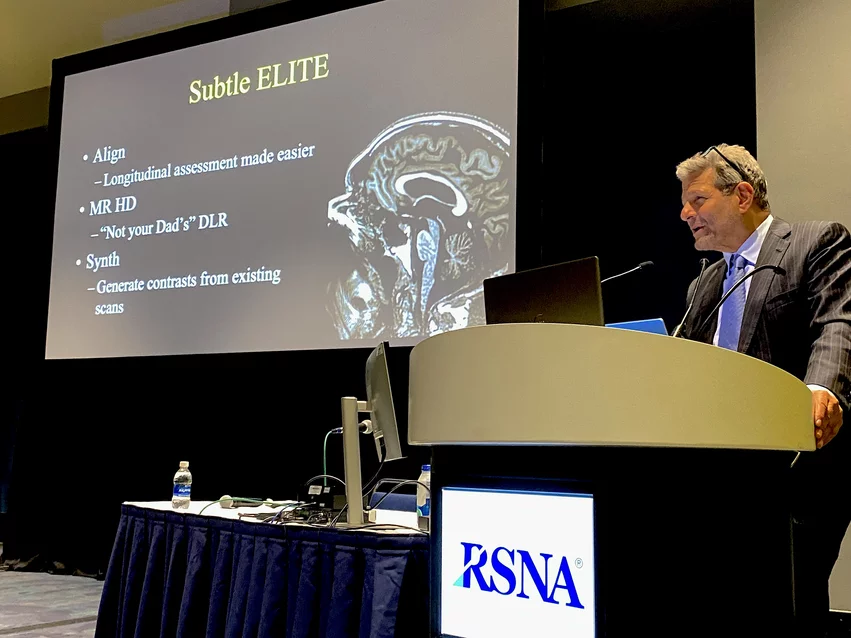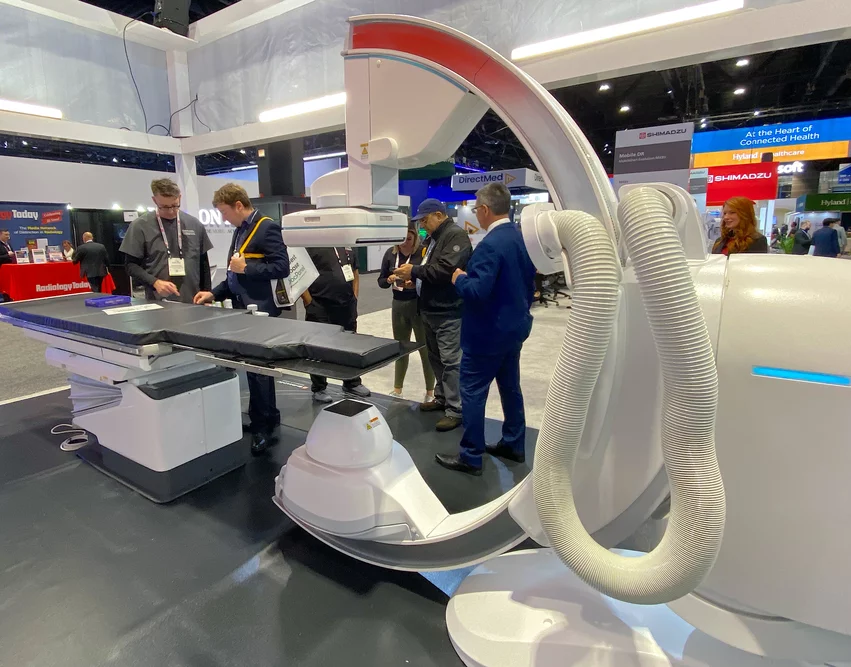Key takeaways from RSNA 2024 for AI, CT, MRI and the radiology staffing shortage
There were several key trends in medical imaging that were evident at the Radiological Society of North America 2024 meeting. These include emerging trends in CT and MRI technologies, the radiologist shortage, and new discussions and adoption of artificial intelligence.
AI part of every conversation at RSNA
RSNA is not only the largest medical imaging conference in the world with more than 700 vendors and about 40,000 attendees this year, but it also is the largest clinical AI conference in the world. The U.S. Food and Drug Administration as of December has cleared about 1,000 clinical AI algorithms. Of these, close to 80% are for medical imaging, and the majority were on display at RSNA. There were 204 exhibitors showcasing at least one AI product this year.
This does not include the thousands of additional nonclinical AI applications embedded in radiology IT systems that do not require FDA review. However, they were a key topic of discussion in vendor booths, ranging from AI for analytics, workflow orchestration, fetching prior exams, pulling relevant patient data from the EMR, support for billing, coding and many other other workflow efficiencies.
AI is clearly seeing adoption in clinical practice across radiology. Many vendors on the floor that that were science project start-ups five years ago are now serious leaders in this space, some with AI installs at hundreds of practices or hospital departments. A couple of AI applications for rapid detection and alerts on mobile phones for stroke, and AI assessment for FFR-CT cardiac blood flow from CT scans, are now included in national guidelines. The consensus from experts Radiology Business spoke with is that the number of AI algorithms included in future updates to guidelines will certainly grow.
Prior to the pandemic, there were questions if AI was a passing fad or a real paradigm shift in radiology. It's now clear AI is indeed the latter. Lagging reimbursement for AI is the main barrier to widespread adoption of standalone AI analysis algorithms, but integrated AI in PACS and advanced visualization software on scanners are now becoming standard.
AI bias and the need to reassess algorithm performance
Among the biggest discussions on AI this year at RSNA was the need to prevent AI bias and to perform quality assurance assessments to make sure AI is still working as intended. Although AI algorithms are required to be locked down in their final FDA-cleared configuration, some algorithms have observed "drift," and this automation bias makes it less accurate over time.
"When it comes to AI bias, it's not just about your patient population; it is also about your equipment or anything that changes the data and keeps it out of distribution from what the training data was," radiology AI expert Nina Kottler, MD, associate chief medical officer for clinical AI at Radiology Partners, explained in an interview with Radiology Business. She added that some on the technical-change aspects may even have a bigger impact than differences in race and ethnicity in a hospital's patient population. These seemingly small changes in the data can impact the quality of AI performance over time.
To address this, health systems need to have a way to assess algorithms. This will likely lead to the creation of new AI administration positions to ensure quality and lead efforts to assess effectiveness of algorithms being looked at for adoption.
But in order to measure something, you need to know how a technology works at its baseline, and many AI algorithms are still a so-called "black box," where data come in and mostly correct answers come out, but how the AI reaches that decision is not always clear. This has led to a push in radiology for transparency in the foundational models of AI that are being adopted. Kottler and other experts speaking at RSNA said companies will need to show the thought process behind AI software so it can be tested at health systems to monitor drift and ensure accuracy.
"As the implantation of AI in departments progresses, what has become clear is that legacy systems we are used to, such as scanners PACS and RIS systems, were built in a time when AI was not a thing. What is becoming clear is that the AI technology does not perform the same over time, and departments need to monitor the performance. We change scanners and protocols frequently, so even though the AI product may have worked well when you first put it in, you really need to keep an eye on that over time," Christoph Wald, MD, PhD, MBA, vice chair of the American College of Radiology Board of Chancellors and chair of the ACR Commission on Informatics, explained in and interview with Radiology Business.
To help radiology departments with this oversight, the ACR recently launched the Assess-AI National Radiology Data Registry. It is capable of monitoring clinical AI results and collecting an array of contextual information on patients to help monitor accuracy. It will also allow centers to see their baseline and shifts over time, or conduct comparisons with other radiology departments participating in the program. Wald said this will help with assessing AI and better understanding the time and cost savings a product might offer.
The RSNA 2024 exhibit hall included more than 200 vendors with artificial intelligence technology, making it the largest clinical AI conference in the world. The FDA has cleared about 1,000 clinical AI algorithms as of this month, with about 80% being for medical imaging. Most were on display at RSNA. Photo By Dave Fornell
New CT technology adds AI, address rise of CCTA
All of the big CT vendors are introducing AI to assist in patient set-up, protocoling, improving image quality, reducing radiation dosage, and speeding up workflows. This is in part to improve efficiency of technologists and reduce errors that can necessitate retakes. It also is partly to address the growing shortage or highly qualified technologists.
In late 2021, the new American College of Cardiology/American Heart Association chest pain assessment guidelines elevated cardiac computed tomography angiography (CCTA) to a class 1A recommendation. Many of the top centers in the country were already using CT in this capacity, but the guidelines helped spur adoption across the country at all types of practices, including community hospitals and outpatient centers. This has resulted it a big demand for cardiac-capable CT systems. Last year at RSNA, four new CT scanners were launched and those vendors were quick to say the scanners were built to enable CCTA. A couple of these scanners also came in at lower price points than the current high-end alternatives with the fastest rotation speeds and resolution that are critical to freezing cardiac motion. This year at RSNA 2024, three more CT scanners were introduced, again with vendors emphasizing their utility in CCTA.
It is unusual for seven CT scanners to be introduced within a year of each other, but it speaks to the level of demand for cardiac CT and how fast AI integration is taking place in the market.
Radiology Business spoke with Diana Litmanovich, MD, chief, cardiothoracic imaging section, at Beth Israel Deaconess Medical Center, and an associate professor, radiology, Harvard Medical School, during RSNA. She said her center has more than doubled the number of CCTA exams performed in 2021, and added several Revolution Apex CT systems to their fleet the past few years to keep up with demand.
At RSNA, GE introduced new AI enhancements to it Revolution Apex scanners with TrueFidelity DL AI to enhance cardiac CT. This AI algorithm offers a new cardiac kernel, enabling high detail at low radiation doses, with improved visual sharpness.
Siemens introduced both a mid-range and lower-cost photon-counting CT systems this year to complement its Naeotom Alpha, which was launched in 2021, and so far the only, work-horse photon-counting system on the market. The expansion of the line with two new scanners appears to be a push for wider adoption of Siemens' technology before GE and Philips commercialize their own photon-counting systems that are in development.
The Naeotom Alpha.Peak will be the new high-end model of its photon-counting CT series, with the fast scan time of 737 mm/second. The Naeotom Alpha.Pro is a lower-cost dual-source photon counting system used to reduce exam times and not for spectral imaging, which is already built into each photon-counting scan. Both systems are pending FDA 510(k) clearance
The original scanner with FDA approval will be renamed the Naeotom Alpha.Prime, which is now being classified as the workhorse scanner of the series.
Philips launched its new CT 5300 system at RSNA, which features a suite of AI-enabled Precise software solutions that assist at every step of the CT workflow, freeing technologists and radiologists from routine, time-consuming tasks. Its Precise Cardiac AI compensates for motion to improve visualization of the coronary arteries during CT imaging, even in patients with rapid heartbeats. There also is a new Precise Brain AI package that auto reformats scans to help improve visualization. In addition, the new AI delivers fast, high-quality image reconstruction with an 80% lower radiation dose, 85% lower noise and 60% improved low-contrast detectability.
AI is changing MRI systems
AI also is being deeply integrated to make MRI systems much more efficient, faster and to improve image quality. All the big MRI vendors now have FDA cleared AI image reconstruction algorithms to help reduce imaging times by 50% or more. Several AI vendors on the expo floor also are partnering with vendors to offer additional enhancements, with Subtle Imaging one example. The vendor enables the creation of synthesized images to overcome motion or ringing artifacts, using much lower doses of gadolinium contrast.
AI also is now automatically isocentering patients and picking optimized protocols to save the technologist time, reduce retakes and accelerate throughput to levels that were not possible just a few years ago. Nearly all MRI vendors on the RSNA expo floor introduced new MRI AI enhancements this year.
There is a push with MRI to reduce the amount of helium in the cryogenic magnet cooling systems because helium is becoming scarce and very expensive. This drives up costs for MRI purchases and ongoing maintenance to top off these systems as gas escapes over time. Philips has been a leader in this area with its BlueSeal MRI technology, using just 7 liters of helium in a permanently enclosed cryogenic circuit, compared to most conventional scanners that use 1,500 liters. The sealed system greatly reduces helium use and also eliminates the need for a vent pipe. The reduced weight makes it much easier and less expensive to install, without the need to reinforce floors. Philips showed the system at RSNA this year and also installed it in a semi-trailer for mobile imaging.
This year, Philips displayed its next-generation 1.5T BlueSeal MRI, 70 cm wide-bore scanner at RSNA 2024. Its main advance is its Smart Reading technology, a cloud-based AI toolset that integrates imaging and reading on the MR scanner. In partnership with computer-aided diagnostics company icometrix, the scanner can help address neurological indications like Alzheimer’s and multiple sclerosis, while imaging biomarker specialist Quibim offers assistance for prostate cancer. Philips also announced a new research partnership with Mayo Clinic to advance cardiac MRI AI applications.
GE Healthcare unveiled new AI enabled 3D imaging capabilities of its Sonic DL AI MRI algorithm. It can enable up to 86% faster scans and enhanced resolution for brain, spine, orthopedic and body imaging. Combined, Sonic DL and GE's AIR Recon DL AI accelerates workflow while improving image quality. Initially launched in 2023 for cardiac MRI, Sonic DL provides up to 12 times scan acceleration while maintaining diagnostic quality.
United Imaging introduce its FDA 510(k)-pending 3T uMR Ultra MRI system at RSNA. It can observe and analyze body movement within the scan. The company said the technology enables the transition of MRI from static photography to dynamic videography of the body in motion.
Voice-operated angiography systems
In interventional radiology and interventional cardiology, there was a unique advancement offered by Shimadzu on its Trinias Opera angiography system at RSNA, where voice commands can now be used to change the C-arm angulation, other movements, and modify the overhead display configuration so that it no longer requires anyone to break the sterile field or press a button. The company first showed this in a booth video at the Transcatheter Cardiovascular Therapeutics 2024 meeting in October, but this was the first time they demonstrated it on a show floor.
United Imaging also showed a similar work-in-progress version of this type of voice command control for its uAngio Aviva angiography system, which is currently pending FDA review.
Radiologist shortage forces more health systems to recruit at RSNA
The radiologist shortage is being felt across the U.S. and it was very evident at RSNA. The number of health system recruiters has doubled from 2019 numbers to about 60. Prior to the pandemic, the recruiters row aisle was a place for attendees to collect pens and was usually very open with only a trickle of visitors. Last year and again this year, it was full of people each time we stopped by, and many were having conversations with recruiters.
Radiology Business spoke with several of these exhibitors and found that rural areas are having the hardest time recruiting radiologists, with some positions remaining open for more than a year.
Radiology Business Management Association board member Schaeffer Smith, MPH, CPA, vice president of finance and operations for Comprehensive Radiology Services, said it has been extremely hard to find radiologists to fill positions in the rural Mississippi communities they serve. There is fierce competition with more recognizable or more metropolitan practices around the country. To illustrate the seriousness of the situation, he said CRS recently made an offer to a breast imager who is in the class of 2027, because she is originally from the area and they want to ensure they can keep her in the community.
"We are recruiting against San Diego, Myrtle Beach, Ft. Lauderdale, Dallas, and several metropolitan areas. And these places can be more desirable to young, single people looking for night life or a sports team, but we actually have a very desirable place to raise a family with a college town and a low cost of living in Hattiesburg, Mississippi," Smith said.
Even larger heath systems were looking to recruit more radiologists as demand exceeds the current number of radiologists they have on hand.
There were 53 recruiters in the recruiters row area of the floor, but another 10 were spread out across both show floors. Those interviewed said this was the only spot they could get because they were first-time exhibitors, or they registered too late to be grouped with the other recruiters.
Several said they are offering packages that allow a better work-life balance through remote work or a hybrid schedule, alongside a higher pay rate than what they offered just a few years ago.
Additionally, RSNA was shooting professional photos for attendees to use on resumes, LinkedIn and websites, and the booth was packed with people waiting in line. The explosion of popularity and longer lines at these professional portrait shoots over the past two years shows the growing interest in technologists and imagers to see what new opportunities might be available.
It is clear that radiologists are in the driver's seat when looking for new job opportunities.





